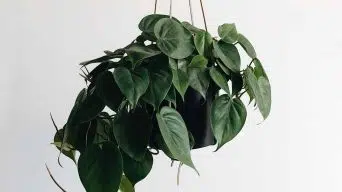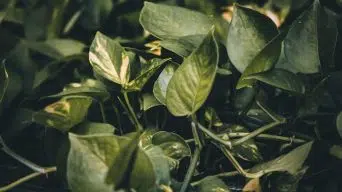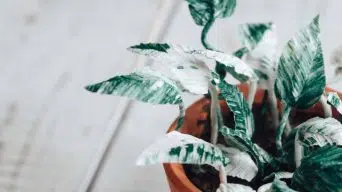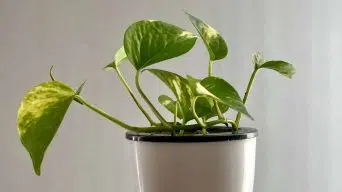Black spots on Pothos leaves usually indicate issues like overwatering, too much sunlight, improper watering, or bacterial infections. Overwatering is a common cause, leading to root or fungal problems. Adjust watering and light to keep your Pothos healthy.
Pothos plants, scientifically known as Epipremnum aureum and commonly referred to as Devil’s Ivy, are easy-to-care-for plants that require indirect sunlight and adequate watering to thrive and bring life to any space.
The vines of Pothos plants can be trained to grow up trellises or along walls, making them an excellent choice for adding a touch of greenery to any space.
The thick, lush foliage cascades down, and the long, trailing vines create an eye-catching display of vibrant green.
But what do you do when you notice black spots on your Pothos?
There are several factors that could cause black dots, and fortunately, most of them are easy to address.
This article will cover the five most common causes of Pothos leaves turning black and provide solutions to address the problem.”
What Causes Black Spots on Pothos Leaves and How Can You Fix It?
Houseplants, such as pothos, are a great way to add a touch of nature to your home. However, they require regular care and attention to ensure they remain healthy and vibrant.
If neglected, they can suffer from a variety of issues, ranging from nutrient deficiencies to pest infestations. It’s important to keep an eye on your houseplants and take action if you notice any signs of distress.
One problem that pothos plants can experience is the development of black spots on their leaves.
These dark spots can be caused by several factors, including excessive watering and insect infestation.
However, fungal diseases are the most common cause of black spots on plants.
To properly diagnose and treat spots on leaves, it’s essential to understand the root cause.
Only then can you take the necessary steps to fix the problem.
Here are the five most common reasons for black spots on pothos leaves:
1. Overwatering
One of the most common causes of pothos black spots is overwatering.
Plants are very sensitive to too much water; if their roots are constantly sitting in water, they will start to rot.
This usually happens because the pot doesn’t have proper drainage, the plant is getting too much water or both..
This can lead to several problems, including pothos root rot, black spots, and yellowing leaves on the plant.
You can tell if your pothos plant is overwatered if the leaves are wilting, yellowing, or falling off.
How To Treat An Overwatered Plant
If you suspect that your pothos plant is overwatered, the first step is to check for proper drainage in the pot.
If the pot lacks adequate drainage, water will accumulate at the bottom and lead to root rot.
When potting plants, using a well-draining potting mix is crucial. This prevents excess water from pooling at the bottom of the pot and causing root rot, which could ultimately jeopardize the plant’s survival.
Ensuring the plant’s health involves incorporating perlite into the soil. Perlite aids in soil aeration, improves drainage, and acts as a barrier between the water in the pooled area at the pot’s bottom and the plant’s roots. This prevents root rot and allows the plant to thrive.
Repotting your plant into a container with drainage holes facilitates proper soil drainage, enabling the plant to access the necessary oxygen and water for optimal growth.
If the pot has drainage holes, yet the plant remains overwatered, it’s possible that you’re providing too much water. To rectify this, reduce the frequency of watering and only water when the soil is dry to the touch.
Use your finger to gauge the soil’s moisture level and adjust your watering accordingly. Water the pothos plant less frequently or only when the soil is dry to the touch.
If the soil is still moist, wait until it dries out before watering again
2. Fungal Diseases
Fungal diseases are another common cause of black leaves.
When the humidity levels are too high, fungal diseases such as sooty mold, leaf spots, and anthracnose can cause black spots on pothos plants, leading to discoloration and eventual death of the plant if not treated promptly.
Sooty Mold
Sooty mold is a type of fungal growth that appears as black spots on the leaves of pothos plants.
The fungus grows on the honeydew produced by aphids and other pests and can quickly spread to cover large areas of the plant.
While sooty mold does not typically cause serious harm to plants, it can impede photosynthesis and cause the Pothos leaves to turn yellow or brown — a clear sign of leaf discoloration.
In addition, sooty mold can make the plant more susceptible to disease.
How To Treat Sooty Mold
If you think your pothos plant has sooty mold, the first thing you need to do is check for pests.
Aphids and other pests produce honeydew, the food source for sooty mold.
If you find pests on your plant, you can remove them by spraying the plant with water or using a natural pest control method.
Once the pests are gone, the sooty mold will start to disappear on its own.
You can also remove sooty mold by wiping it off the leaves with a damp cloth.
Fungal Leaf Spot
Leaf spot is another type of fungal disease that can cause black and brown spots on pothos leaves.
Various fungi cause leaf spot, and they can quickly spread and kill a plant if left untreated.
Leaf spot fungal infection usually begins as small, water-soaked spots on the leaves that eventually turn brown or black.
The spots are often surrounded by a yellow halo, which can eventually lead to the death of the leaves.
How To Treat Leaf Spot
If you think your pothos plant has leaf spot, the first thing you need to do is remove any affected leaves.
Leaf spot is very contagious and can quickly spread to other parts of the plant.
After removing the affected leaves, you should disinfect your pruning shears with rubbing alcohol to prevent the disease from spreading.
Once the affected leaves have been removed, you can treat leaf spot by spraying the plant with a natural fungicide.
There are some different natural fungicides that you can use, but one of the most effective is neem oil.
Neem oil is a natural insecticide and fungicide that is safe for use on plants.
To use neem oil, simply mix it with water and spray it on the affected areas of the plant.
Anthracnose
Anthracnose is another fungal disease that can cause leaves to turn black.
A variety of different fungi causes anthracnose, and it typically affects plants that are stressed or growing in shady, damp conditions.
Anthracnose symptoms include black or brown spots on the pothos stems and leaves.
This disease can quickly spread and kill a plant if left untreated.
How To Treat Anthracnose
If you think your pothos plant has anthracnose, you first need to improve its growing conditions.
Anthracnose thrives in shady, damp conditions, so try to provide your plant with more sunlight and improve the drainage of its pot.
Using a pair of scissors, carefully prune away any dead or infected leaves, stems, or branches from the plant, taking care to make clean cuts so as to avoid damaging the healthy parts of the plant.
Anthracnose is very contagious and can quickly spread to other parts of the plant.
After removing the affected plant parts, you should disinfect your pruning shears with rubbing alcohol to prevent the disease from spreading.
Then, you can treat anthracnose by spraying the plant with a natural fungicide like neem oil.
Neem oil is a natural insecticide and fungicide that is safe for use on pothos plants.
To use neem oil, simply mix it with water and spray it on the affected areas of the plant.
3. Bacterial Infections
Bacteria can cause black spots to develop on Pothos plants.
Bacterial diseases are often spread by contaminated water or tools, and they can quickly kill a plant if left untreated.
The most common bacterial diseases that affect pothos plants are bacterial leaf spot and bacterial blight.
Bacterial Leaf Spot
Bacterial leaf spot is a common disease that affects many different types of plants, including pothos.
These bacteria thrive in warm, humid conditions and can be spread by rain or watering.
Symptoms of the bacterial leaf spot disease include small, dark brown, or black spots on the leaves.
A yellow halo may surround the spots, and the leaves may eventually turn completely yellow and die.
How To Treat Bacterial Leaf Spot
To prevent bacterial leaf spot, always water your pothos plants from the base and avoid getting the leaves wet.
If your plant is already infected, you must remove any affected leaves and dispose of them.
You should also disinfect your tools and equipment to prevent the spread of bacteria.
If the disease is severe, you may need to treat your plant with a copper-based fungicide.
Bacterial Blight
Bacterial blight is a common plant disease that can affect many plants, including pothos.
This disease is caused by a bacterium called Pseudomonas cichorii, which thrives in warm, moist conditions.
Symptoms of bacterial blight include black spots on the leaves, stems, and flowers of affected plants.
The spots may be surrounded by a yellow halo, which can eventually lead to the death of the plant.
How To Treat Bacterial Blight
Constantly water your pothos plants from the base to prevent bacterial blight and avoid getting the leaves wet.
If your plant is already infected, you must remove any affected leaves and dispose of them.
You should also disinfect your tools and equipment to prevent the spread of bacteria.
If the disease is severe, you may need to treat your plant with a copper-based fungicide.
4. Pests
Pests can also be the reason behind black spots on leaves.
Aphids, mealybugs, scale insects, and spider mites are all common pests that can infest pothos plants.
These insects suck the sap from the affected plants’ leaves, stems, and flowers.
This can cause the Pothos foliage to turn brown or yellow and eventually die.
Pests can also spread diseases, so getting rid of them as soon as possible is essential.
How To Control Pests
To prevent pests, always inspect your pothos plants carefully before purchasing them.
If you spot any bugs, do not purchase the plant.
Additionally, it’s advisable to quarantine new plants for a few weeks to ensure they are not infested.
If your plant is already infested, you can manually remove the pests.
Use a cotton swab dipped in rubbing alcohol to eliminate mealybugs and spider mites.
For aphids, you can spray a mixture of water and soap to eradicate them effectively.
Alternatively, you can employ insecticidal soap or neem oil to manage aphids.
These products are safe for humans and animals while effectively eliminating the most common pests.
Avoid using pesticides on pothos plants, as they are sensitive to these chemicals. Pesticides can lead to leaf burn, discoloration, and even death if exposed to excessive amounts.
Therefore, exercise caution when using any treatments and always carefully read and follow the instructions before applying them to your plants.
5. Fertilizer Burn
Fertilizer burn can also cause pothos leaves to turn black.
This common problem occurs when too much fertilizer is applied to the plant.
Overfertilizing can deprive the plant of essential nutrients, resulting in burned roots and leaves that turn brown or black.
Pothos plants need very little fertilizer, so you should only fertilize them once a month during the growing season.
How To Prevent Fertilizer Burn
If you notice black dots on pothos leaves, it is likely due to fertilizer burn.
To prevent this issue, always adhere to the directions on the fertilizer label.
When applying fertilizer, it is crucial to ensure the correct amount is used and evenly spread over the entire treated area.
This will help prevent potential problems stemming from incorrect fertilizer application.
If your plant is already suffering from a burn, you can attempt to save it by leaching the soil with water.
To do this, thoroughly water the plant and then allow excess water to drain away.
Additionally, it’s advisable to flush the soil with water every few weeks to eliminate any remaining fertilizer residues.
6. Too Much Sunlight
Sunburn on Pothos Leaves is another common issue, especially when the plant is exposed to excessive direct sunlight.
Pothos plants prefer temperatures between 65-85 degrees Fahrenheit and thrive best when kept in bright, indirect light, away from direct sunlight, as they are native to the understory of tropical forests.
Too much direct sun can cause the leaves to turn yellow, develop brown, dark spots, or even turn black due to sunburn.
How to Prevent Sunburn
- Provide Indirect Light: Place your pothos in a location where it can receive bright, indirect light. Avoid exposing it to direct sunlight for extended periods.
- Adjust Placement: If your pothos is near a window where it receives direct sunlight, consider moving it slightly away or using sheer curtains to filter the light.
- Rotate the Plant: Occasionally rotate the plant to ensure all sides receive an even amount of light.
- Monitor Light Levels: Pay attention to the light levels in the area where your pothos is placed and adjust its location accordingly to ensure it’s receiving appropriate lighting.
- Use Artificial Lighting: If natural light is insufficient or inconsistent, consider using artificial grow lights specifically designed for indoor plants to provide adequate and consistent light.
- Observe Leaf Color and Texture: Regularly check the color and texture of the leaves. If you notice any signs of sunburn (yellowing, browning, or blackening), take action to adjust the lighting conditions.
If you are growing a plant indoors, it is important to ensure it receives the right amount and type of light exposure.
Too much or too little can cause sunburn and damage to its foliage. However, by providing the appropriate amount of light indoors, you can ensure your plant stays healthy and vibrant.
7. Underwatering
Underwatering is another common issue that can cause problems for pothos plants. When a plant doesn’t receive enough water, its leaves can start to turn brown or black.
Here are some signs that your pothos is underwatered:
- Dry Soil: Check the soil by inserting your finger about an inch deep. If the soil feels dry at this depth, it’s a sign that the plant needs water.
- Wilting Leaves: Pothos leaves will start to wilt and become limp when they’re not getting enough water.
- Crispy Edges: The edges of the leaves may become crispy and brown due to dehydration.
To prevent underwatering, follow these steps:
- Establish a Watering Routine: Develop a consistent watering schedule based on the plant’s needs and adjust it according to the season. Pothos plants generally like to be watered when the top inch of soil feels dry.
- Monitor Moisture Levels: Regularly check the moisture level of the soil and water the plant when needed. Ensure that the soil stays evenly moist but not waterlogged.
- Ensure Proper Drainage: Make sure the pot has drainage holes to allow excess water to escape. Standing water can lead to root rot.
- Check Environmental Factors: Consider factors like humidity, temperature, and air circulation. Adjust these elements to create a suitable environment for your plant.
Remember, finding the right balance in watering is key to keeping your plant healthy and vibrant.
If you notice signs of underwatering, adjust your watering habits accordingly to help your pothos thrive.
How To Prevent Black Spots On Pothos Leaves
Pothos plants are relatively easy to care for, but they can be susceptible to issues like black spots on the leaves.
There are a few things you can do to prevent this problem:
- Water your pothos regularly, but ensure the soil is dry between waterings.
- Water from the bottom so that the leaves don’t stay wet.
- Use a well-draining potting soil mix.
- Provide bright indirect light, but avoid direct sunlight, which can scorch the leaves.
- Provide good air circulation around the plant.
- Avoid using too much fertilizer, as this can cause black spots on the leaves.
- If you notice black spots, remove the affected leaves and dispose of them.
If you follow these tips, you should be able to prevent pothos black spots.
Final Thoughts
A common issue that many houseplant owners face is the development of black spots on pothos leaves. These spots can be caused by a variety of factors, including disease, overwatering, underwatering, and pests.
Addressing this problem promptly is crucial to ensure the health and longevity of the houseplant.
If you notice black spots on your pothos leaves, try to identify the cause so you can take appropriate action.
Taking the time to identify the cause of the problem and then implementing the appropriate action can often lead to an effective and efficient resolution of the issue.
Gardening is an excellent way to care for your pothos plant. It allows you to provide the necessary nutrients and moisture for it to thrive while enabling you to monitor its progress and promptly address any arising issues.
With the right care, your plants should flourish in either your indoor or outdoor garden.







